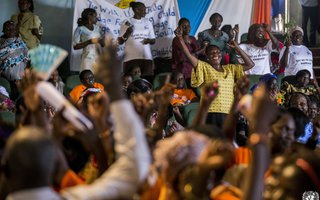Is peace possible in South Sudan?

It is now six years since South Sudan gained independence. The optimism that greeted the country’s birth following years of war was shattered in 2013 when political disagreement within the Sudan People’s Liberation Army (SPLA) once again plunged the country into civil war.
A delicate peace agreement that was signed in different locations by both parties in August 2015, broke down and there was even more intense fighting last year. President Salva Kiir declared a unilateral ceasefire in May this year, but hostilities have persisted. There are daily reports of widespread violence, including scorched earth looting, which forced more than two million people from their homes and led the United Nations to declare South Sudan the fastest growing refugee crisis in the world.
But within the seemingly endless cycles of violence that have gripped South Sudan for the past three years, there have been pockets of peace; local conflicts that have been resolved through an age-old process of building trust and encouraging warring parties to talk. Uncovering what has worked in the past, and combining this with a comprehensive national dialogue process could enable the young country to look to a more peaceful future.
Past lessons in community reconciliation
The Wunlit Peace conference is often hailed as a shining example of successful peacebuilding in the region. The conference brought together representatives of the two largest ethnic groups in the country – Dinka and Nuer – to resolve an eight year long conflict over grazing rights.
Even before formal meetings began, traditional community leaders, and those supporting the peace process focused on establishing common ground between the two sides. Often preparation and processes are as important as the issues being discussed, and when it comes to peace, building confidence and trust is one of the most important first steps.
In contrast, when delegates were brought together for the Boma peace conference in September 2016, preparation was so inadequate that most refused to even stay the night as they feared for their own safety.
Ensuring participation of the people
Just as important as preparing for discussions, is deciding who takes part. The question of a national dialogue is a divisive issue. If the National Dialogue process is to be successful, politicians must engage a broad cross-section of South Sudanese society and all shades of political opposition, including the main opposition and armed groups.
Past peacebuilding initiatives that have worked in South Sudan, have seen traditional community leaders such as tribal elders, local bishops or respected religious groups play an integral role as intermediaries between warring parties. These are people with moral authority who also understand the importance of the oral traditions and customs that are used to reunite communities.
The voices of young people need to be heard in these dialogue and reconciliation processes – especially those at the heart of conflict. The escalation of armed cattle raiding and abductions in certain areas of the country have driven young people into establishing organised militia to protect their homes – the Arrow Boys of Western Equatoria have proved a formidable force in countering cattle raids. But these young people have rarely been included in local peace processes, meaning violent confrontation is their only option.
Women, too, are so often excluded from these negotiations. However, when women are given the opportunity, they have proved a powerful influence in local peace brokering. Analysis of global peace processes has shown that when women are included, there is a 20% increase in the probability of an agreement lasting at least two years. At the Wunlit peace process, one third of delegates were women and they played a vital role as mediators of the ‘truth’.
Challenges to dialogue
President Kiir recently stepped down as patron of the National Dialogue process to allow the South Sudanese people to take the lead; a move which divided public opinion. People remain sceptical. With restrictions on the press and freedom of expression, and around four million displaced, the challenges could well outweigh these sentiments. It will be difficult for effective dialogue to take place without an environment that is conducive.
Looking to the future
So much can be learnt from the successes and failures of past peace initiatives in South Sudan. The challenge now is to link successful local innovations to the national level. To be truly effective, reconciliation in South Sudan needs to build on the state and non-state structures that exist within communities and link these to such national structures and processes.
This will be a long and complex process. It will require trusted intermediaries who can listen to the concerns of local communities and take these to a national level. But if the National Dialogue has clear goals, takes a long-term approach and includes the voices and views of a whole cross-section of society – then a peaceful future could still be in sight for South Sudan.





